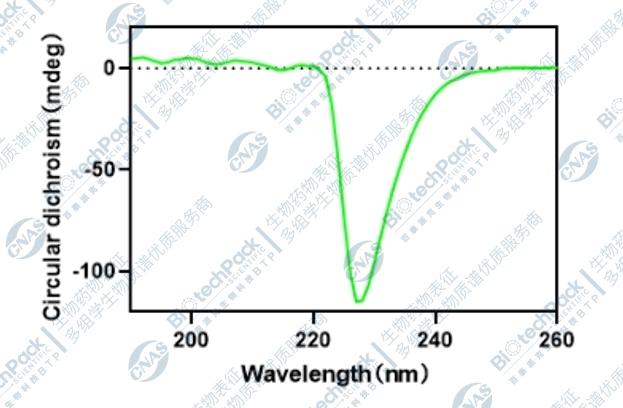Circular Dichroism Analysis (CD)
In recent years, with the ongoing development of drug development research, Circular Dichroism (CD) analysis has become an indispensable tool in the development and research of protein and peptide biopharmaceuticals. A circular dichroism spectrometer utilizes the circular dichroism of proteins and their asymmetric absorption of left and right circularly polarized light for structural analysis. The main optically active groups in proteins or peptides include peptide bonds, aromatic amino acid residues, and disulfide bonds. When the absorption of plane circularly polarized light is asymmetric, an absorption difference is generated, causing an amplitude difference in the polarization vector of the light, transforming the circularly polarized light into elliptically polarized light, which is the circular dichroism of proteins.By using a circular dichroism scanner to measure the circular dichroism spectra of biological macromolecules such as proteins, the secondary structure of biological macromolecules can be identified simply and quickly. This technique is widely used in fields such as protein folding, conformation studies, and enzyme kinetics.
Biotech Co., Ltd. BTP has established a circular dichroism analysis platform based on the Jasco circular dichroism spectrometer to study the secondary structure of protein and peptide biopharmaceuticals. The instrument is equipped with temperature control and titration modules, which can further study the effects of temperature, pH, ionic strength, and other factors on protein folding state and stability.
Circular Dichroism Technology
Circular dichroism is the most widely used method for determining protein secondary structure and is a quick, simple, and relatively accurate method for studying protein conformation in dilute solutions. It can be measured in solution, which is closer to the physiological state of proteins. The method is fast and convenient, and sensitive to conformational changes, making it a primary tool for studying protein secondary structures and is widely used in the field of protein conformation research.
Experimental Instruments
• Circular Dichroism Spectrometer (Jasco)
Applications
• Infer the configuration and conformation of substances
• Analysis of secondary and higher structure information of protein/peptide biopharmaceuticals
Case Example Diagram
After centrifugation, take the clear part of the solution for machine detection.
Far-UV Detection Parameters:
Start Wavelength(Begin) 190 nm,
End Wavelength(End) 260 nm,
Step 1 nm, Repeat 1 time,
Acquisition Time 1 s/point,
Cuvette Width 0.1 cm.
The following results were obtained:


Common Issues:
Question 1: What do the spectra scanned by circular dichroism in the near-UV and far-UV regions represent?
Answer:The circular dichroism spectra scanned in the far-UV region provide information on the secondary structure of proteins. It reflects the spatial arrangement of peptide bonds in the protein, and by calculation, the proportion of different secondary structural elements (such as α-helices, β-sheets, turns, and random coils) in the protein can be obtained. This information is crucial for understanding the structural characteristics and stability of proteins.
The circular dichroism spectra scanned in the near-UV region provide information about the side chains of proteins. It reflects the spatial arrangement of amino acid residues with chromophores (such as tryptophan, phenylalanine, tyrosine) in the protein. Additionally, near-UV scanning can reveal changes in the microenvironment of disulfide bonds within proteins. This information is important for studying the function and interactions of proteins.
Question 2: What software is used to analyze protein secondary structure, and what are its advantages?
Answer:Currently, there are various software tools available for analyzing and predicting protein secondary structure. BTP uses CDNN software for analysis. CDNN is a secondary structure calculation software based on deep neural network technology, which can predict the secondary structure composition by analyzing the amino acid sequence of proteins. Compared to other software, CDNN has the following advantages: First, it provides highly accurate calculation results, enabling accurate prediction of protein secondary structure. Second, CDNN has high-speed computational capability, allowing rapid processing of large-scale protein sequence data. Additionally, CDNN is cost-effective, saving analysis costs and time. This software has been validated and applied in many biomedical applications, such as drug design and protein structure prediction.
Related Services
How to order?





